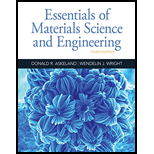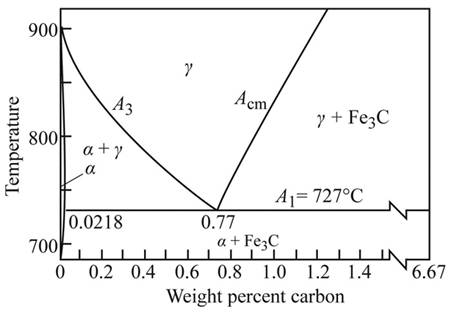
(a)
Interpretation:
The amount, composition and hardness of material at
Concept Introduction:
Material hardness is the property of a metal due to which material resist the plastic deformation. Plastic deformation means material deformation which undergoes non-reversible change. Hardness is the property of any material which process stiffness resistance to bending, scratching or cutting. Hardness is not constant or fixed for all material, but it depends upon strength and plasticity of metal. Material hardness is expressed in terms of hardness number.
Answer to Problem 12.102P
The composition, hardness and amount are
Explanation of Solution
Given:
Graph showing

As shown in the given diagram, at the line
As from the figure, the effect of hardness of martensite in steel, the hardness of martensite at
Where,
Put, the values in lever rule,
(b)
Interpretation:
The amount, composition and hardness of material at
Concept Introduction:
Material hardness is the property of a metal due to which material resist the plastic deformation. Plastic deformation means material deformation which undergoes non-reversible change. Hardness is the property of any material which process stiffness resistance to bending, scratching or cutting. Hardness is not constant or fixed for all material, but it depends upon strength and plasticity of metal. Material hardness is expressed in terms of hardness number.
Answer to Problem 12.102P
The composition, hardness and amount are
Explanation of Solution
From the given figure, draw a line at
The lever rule is given by,
Where,
Put the values in lever rule
(c)
Interpretation:
The amount, composition and hardness of material at
Concept Introduction:
Material hardness is the property of a metal due to which material resist the plastic deformation. Plastic deformation means material deformation which undergoes non-reversible change. Hardness is the property of any material which process stiffness resistance to bending, scratching or cutting. Hardness is not constant or fixed for all material, but it depends upon strength and plasticity of metal. Material hardness is expressed in terms of hardness number.
Answer to Problem 12.102P
The composition, hardness and amount are
Explanation of Solution
Calculate the amount of martensite from the heating temperature
Therefore at
Applying lever rule at a heating temperature
Put,
Therefore,
The effect of carbon content on the hardness of martensite in steel, the amount of hardness for martensite composition
(d)
Interpretation:
The amount, composition and hardness of material at
Concept Introduction:
Material hardness is the property of a metal due to which material resist the plastic deformation. Plastic deformation means material deformation which undergoes non-reversible change. Hardness is the property of any material which process stiffness resistance to bending, scratching or cutting. Hardness is not constant or fixed for all material, but it depends upon strength and plasticity of metal. Material hardness is expressed in terms of hardness number.
Answer to Problem 12.102P
The composition, hardness and amount are
Explanation of Solution
From the diagram, the eutectoid portion of
r =0.30%c
Applying lever rule, calculate the composition of martensite at them
Calculate the amount of hardness at temperature
From the figure, the effect of carbon content hardness at
Want to see more full solutions like this?
Chapter 12 Solutions
Essentials Of Materials Science And Engineering
- Consider 0.65 kg of N2 at 300 K, 1 bar contained in a rigid tank connected by a valve to another rigid tank holding 0.3 kg of CO2 at 300 K, 1 bar. The valve is opened and gases are allowed to mix, achieving an equilibrium state at 290 K. Determine: (a) the volume of each tank, in m³. (b) the final pressure, in bar. (c) the magnitude of the heat transfer to or from the gases during the process, in kJ. (d) the entropy change of each gas and of the overall system, in kJ/K.arrow_forwardWhat are the two errors in my pseudocode?Module getAverage(Integer value1, Integer value2, Integer value3) Declare Integer average average = value1 + value2 + value3 / 3 Display average End Modulearrow_forwardWhere did I make an error in my pseudocode module???Code:Module main() Call raiseToPower(2, 1.5) End main Module raiseToPower(Real value, Integer power) Declare Real result Set result = value ^ power Display result End raiseToPowerarrow_forward
- Why does my pseudocode not perform what I asked? Don't know whats wrong with it.// This program asks the user to enter a value // between 1 and 10 and validates the input. Declare Integer value // Get a value from the user. Display "Enter a value between 1 and 10." Input value // Make sure the value is between 1 and 10. While value < 1 AND value > 10 Display "ERROR: The value must be between 1 and 10." Display "Enter a value between 1 and 10." Input value End Whilearrow_forwardWhat's wrong with my pseudocode? // The calcDiscountPrice function accepts an item’s price and // the discount percentage as arguments. It uses those // values to calculate and return the discounted price. Function Real calcDiscountPrice(Real price, Real percentage) // Calculate the discount. Declare Real discount = price * percentage // Subtract the discount from the price. Declare Real discountPrice = price – discount // Return the discount price. Return discount End Functionarrow_forwardNeed help converting my pseudocode to python, AND have a flowchart showing everything!The code: Function getScore() // Prompt the user to enter a test score Display "Enter a test score as a percentage (0-100): " Input score // Return the score entered by the user Return scoreEnd Function Function getGPAPoint(Integer score) // Determine GPA point based on the score If score >= 90 Then Return 4.0 Else If score >= 80 Then Return 3.0 Else If score >= 70 Then Return 2.0 Else If score >= 60 Then Return 1.0 Else Return 0.0 End IfEnd Function Function getAverage() // Initialize variables to store the sum of scores and GPA points totalScore = 0 totalGPA = 0.0 // Loop to collect 5 test scores For i = 1 to 5 Do score = getScore() // Call getScore function to get a test score totalScore = totalScore + score // Add score to totalScore gpaPoint = getGPAPoint(score) // Convert…arrow_forward
- Where did I make an error in my pseudocode module???Code:Module main() Call raiseToPower(2, 1.5) End main Module raiseToPower(Real value, Integer power) Declare Real result Set result = value ^ power Display result End raiseToPowerarrow_forwardI need help writing pseudocode for calculating class score average by putting in 5 test scores, and showing the average from all 5 inputs and the GPA score.Starting with 3 functions outside of a main module. The functions are getScore(), getGPAPoint(Integer score), and getAverage(). Function getscore is an input for a grade as a class percentage. Function getGPAPoint will calculate the score into a GPA point and return as a float (values of 90-100 as 4.0, 80-89 as 3.0, 70-79 as 2.0, 60-69 as 1.0, and anything below 60 as 0.) Function averageGPA will finally make a call to both previous functions when the user inputs numbers 5 times that then calculates the average (add up all the scores, divide by 5) and the average grade alongside displaying the average GPA. End result is a main module that makes a proper call to the averageGPA function and display its results. Need help with this!arrow_forwardPlease original work Why is integration between data collection and business analysis so important to success in an organization that uses business analytics? How can a company that is just starting to use business analytics set up its program for success right from the beginning? Please cite in text references and add weblinksarrow_forward
- How to make a 1 bit adder with CLA?arrow_forward(Read Image) (Answer: ω = 1.10 rad/sec CW)arrow_forwardI need help writing pseudocode for this function. The following pseudocode statement calls a function named half, which returns a value that is half that of the argument. (Assume both the result and number variables are Real.) Set result = half(number)arrow_forward
 MATLAB: An Introduction with ApplicationsEngineeringISBN:9781119256830Author:Amos GilatPublisher:John Wiley & Sons Inc
MATLAB: An Introduction with ApplicationsEngineeringISBN:9781119256830Author:Amos GilatPublisher:John Wiley & Sons Inc Essentials Of Materials Science And EngineeringEngineeringISBN:9781337385497Author:WRIGHT, Wendelin J.Publisher:Cengage,
Essentials Of Materials Science And EngineeringEngineeringISBN:9781337385497Author:WRIGHT, Wendelin J.Publisher:Cengage, Industrial Motor ControlEngineeringISBN:9781133691808Author:Stephen HermanPublisher:Cengage Learning
Industrial Motor ControlEngineeringISBN:9781133691808Author:Stephen HermanPublisher:Cengage Learning Basics Of Engineering EconomyEngineeringISBN:9780073376356Author:Leland Blank, Anthony TarquinPublisher:MCGRAW-HILL HIGHER EDUCATION
Basics Of Engineering EconomyEngineeringISBN:9780073376356Author:Leland Blank, Anthony TarquinPublisher:MCGRAW-HILL HIGHER EDUCATION Structural Steel Design (6th Edition)EngineeringISBN:9780134589657Author:Jack C. McCormac, Stephen F. CsernakPublisher:PEARSON
Structural Steel Design (6th Edition)EngineeringISBN:9780134589657Author:Jack C. McCormac, Stephen F. CsernakPublisher:PEARSON Fundamentals of Materials Science and Engineering...EngineeringISBN:9781119175483Author:William D. Callister Jr., David G. RethwischPublisher:WILEY
Fundamentals of Materials Science and Engineering...EngineeringISBN:9781119175483Author:William D. Callister Jr., David G. RethwischPublisher:WILEY





